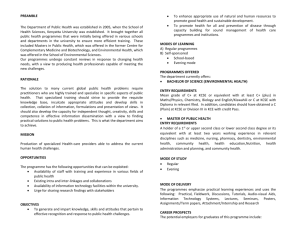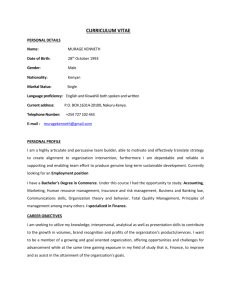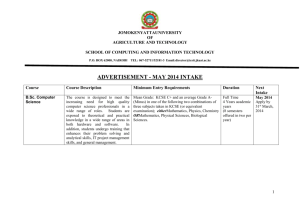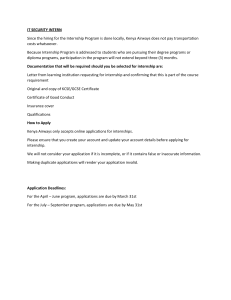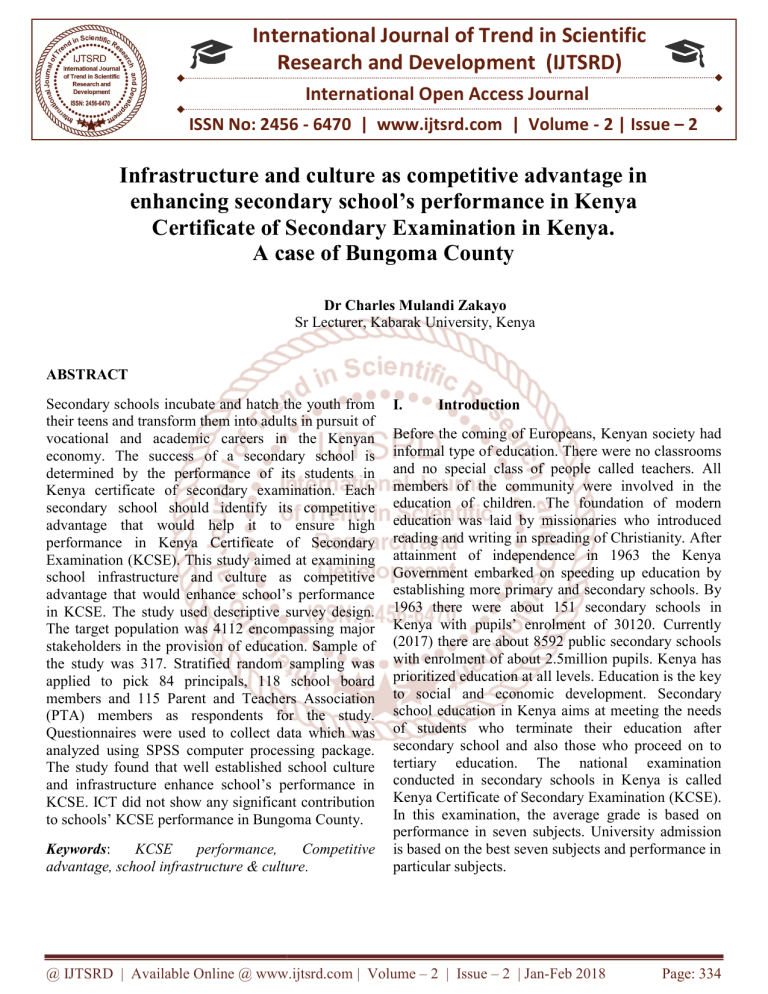
International Journal of Trend in Scientific
Research and Development (IJTSRD)
International Open Access Journal
ISSN No: 2456 - 6470 | www.ijtsrd.com | Volume - 2 | Issue – 2
Infrastructure and culture as competitive advantage in
enhancing secondary school’s performance in Kenya
Certificate of Secondary Examination in Kenya.
A case of Bungoma County
Dr Charles Mulandi Zakayo
Sr Lecturer, Kabarak University, Kenya
ABSTRACT
Secondary schools incubate and hatch the youth from
their teens and transform them into adults in pursuit of
vocational and academic careers in the Kenyan
economy. The success of a secondary school is
determined
ermined by the performance of its students in
Kenya certificate of secondary examination. Each
secondary school should identify its competitive
advantage that would help it to ensure high
performance in Kenya Certificate of Secondary
Examination (KCSE). This
is study aimed at examining
school infrastructure and culture as competitive
advantage that would enhance school’s performance
in KCSE. The study used descriptive survey design.
The target population was 4112 encompassing major
stakeholders in the provisionn of education. Sample of
the study was 317. Stratified random sampling was
applied to pick 84 principals, 118 school board
members and 115 Parent and Teachers Association
(PTA) members as respondents for the study.
Questionnaires were used to collect data which was
analyzed using SPSS computer processing package.
The study found that well established school culture
and infrastructure enhance school’s performance in
KCSE. ICT did not show any significant contribution
to schools’ KCSE performance in Bungoma County.
Keywords:
KCSE
performance,
Competitive
advantage, school infrastructure & culture
culture.
I.
Introduction
Before the coming of Europeans, Kenyan society had
informal type of education. There were no classrooms
and no special class of people called teachers. All
members of the community were involved in the
education of children. The foundation of modern
education
ion was laid by missionaries who introduced
reading and writing in spreading of Christianity. After
attainment of independence in 1963 the Kenya
Government embarked on speeding up education by
establishing more primary and secondary schools. By
1963 there were about 151 secondary schools in
Kenya with pupils’ enrolment of 30120. Currently
(2017) there are about 8592 public secondary schools
with enrolment of about 2.5million pupils. Kenya has
prioritized education at all levels. Education is the key
to social
al and economic development. Secondary
school education in Kenya aims at meeting the needs
of students who terminate their education after
secondary school and also those who proceed on to
tertiary education. The national examination
conducted in secondary schools in Kenya is called
Kenya Certificate of Secondary Examination (KCSE).
In this examination, the average grade is based on
performance in seven subjects. University admission
is based on the best seven subjects and performance in
particular subjects.
@ IJTSRD | Available Online @ www.ijtsrd.com | Volume – 2 | Issue – 2 | Jan-Feb
Feb 2018
Page: 334
International Journal of Trend in Scientific Research and Development (IJTSRD) ISSN: 2456-6470
II.
Statement of the problem.
Since independence in 1963, the education system in
Kenya has never been a level playing ground. The
KCSE examination confirms that there is disparity
among various secondary schools, yet KCSE
certificate is used as a form of enhancement, greater
individual autonomy, empowerment and distribution
of opportunities for both boys and girls graduating
from these secondary schools. Each school should
identify and exploit its competitive advantage to
enhance its performance in KCSE. The researcher
opted to evaluate the role of school infrastructure and
culture as competitive advantage in KSCE
performance in Public secondary schools in Kenya a
case of Bungoma County.
III.
IV.
Objectives of the study
Assessment of school infrastructure as a
competitive advantage in KCSE performance in
public secondary schools in Bungoma County
Assessment of school culture as competitive
advantage in KCSE performance in public
secondary schools in Bungoma County
Operational definition of terms used in the
study
Competitive advantage: Competitive advantage
is a situation whereby a secondary school
attributes allows it to perform better than other
schools by achieving a higher mean score in
Kenya Certificate of Secondary Examination.
(ii) Model of Competitive Advantage
(iii) School infrastructure
According to Oyoo (2012), school infrastructure is a
key base for learning in schools. School infrastructure
School infrastructure:
School infrastructure
include classrooms, dormitory and laboratories for
science practical
School Culture: School culture includes norms
and rituals that bring sense of belonging,
participation, peer relationship, work habits, social
courtesy and a strong commitment to academic
achievement.
2. Literature Review
(i) Theoretical Review
Competitive advantage exists when the firm is able to
deliver the same benefits as competitors but at a lower
cost (cost advantage), or deliver benefits that exceed
those of competing products (product differentiation
advantage). Competitive advantage enables the firm
to create superior value for its products and services
thus, higher profit for itself and higher customer
satisfaction. Resource-based view emphasizes that a
firm utilizes its resources and capabilities to create a
competitive advantage that ultimately results to
superior value creation.
Sustainable competitive advantage is the prolonged
benefit of implementing some unique values thus
creating a unique combination of internal
organizational resources and capabilities that cannot
be replicated by competitors. The strategy applied
here is creating products, processes and services that
cannot be matched by competitors and coming up
with ways of sustaining it.
include classrooms, science laboratories, open fields
for games, game equipments, dormitories, sanitation
facilities and others. It is in classrooms were day to
@ IJTSRD | Available Online @ www.ijtsrd.com | Volume – 2 | Issue – 2 | Jan-Feb 2018
Page: 335
International Journal of Trend in Scientific Research and Development (IJTSRD) ISSN: 2456-6470
day formal teaching and learning takes place. From
libraries learners get the opportunity to conduct their
own personal studies or research. Extra-curricular
activities take place in the field. Teachers and students
need to be housed in the school and at the same time
need sanitation facilities like toilet, waste disposal
services, clean water etc. For this reason, school
infrastructure is a very important component in
ensuring successful school performance in both
internal and national exams.
Karimi (2011) identified strong relationship between
science laboratories, text-books and classrooms with
students’ performance in KSCE. Schools with these
facilities perform better in exams than those without.
Experience and high qualification of teachers
contribute to higher performance of students in
national examinations but Ambogo (2012) found
significant difference in schools performance in
KSCE despite the schools having the same type of
teachers in terms of education level and teaching
experience.
According to Mong’are (2011) the management of
physical resources is a crucial aspect of the overall
management of a school. The physical resources play
a key role in the attainment of the school’s intended
objectives. A direct correlation exists between quality
of school facilities provided and performance in
national examinations. Proper management of
physical resources therefore makes a school to stay on
top at KCSE performance. According to Okeno
(2011)
favorable
attitude
towards
school
infrastructure and quality facilities promote
performance in secondary school examination.
The Kenya Education Staff Institute KESI (2011)
highlights the importance of information and
communication Technology (ICT) in education.
Beside effective teaching /learning, using ICT can
help to improve teacher and student skills and
performance. It can also help to maintain high quality
teaching /learning while cutting down on teaching and
using cheaper aids. ICT applications improve teacher
and student motivation. It makes teaching and
learning more varied and interesting thereby
enhancing sustained performance in examinations.
Schools with adequate teaching and learning
materials perform better in examinations. According
to (Kosgey et al 2006) it is costly to construct or
expand schools. Disbursement of free secondary
school funds poses a challenge as schools in remote
areas receive the government funds at the end of the
term instead of beginning of the term. According to
Glewwe and Jacoby (2005) many students in
developing countries travel long distances to attend
schools. This affects their performance in school.
(iv)
The role of
performance
the
School
Culture
on
According to Omusonga, Kazadi and Indoshi (2006)
school culture refers to a set of accepted beliefs and
norms that govern people’s conduct in a school.
Schools with a culture that favors teachers’ capacity
building, parental involvement, career guidance and
counseling, teaching and learning tend to have high
expectations for and recognition of academic and cocurricular achievement. Such schools tend to perform
better in the national examinations. Schools with a
culture that emphasizes on good instructional policies
perform better in KCSE compared to those which
have weak instructional policies (Mwangi 2011).
The Character Education Partnership (CEP, 2010)
points out that, education in Kenya is at defining
moment. Successful schools foster both academic
excellence and ethics. Such schools have positive
culture. A positive school culture is broadly defined to
include the school wide ethos and the culture of
individual students, high expectations for learning and
achievement, a safe and caring environment, shared
values and relational trust, a powerful pedagogy and
curriculum, high students motivation and engagement,
a professional faculty culture and partnership with
families and the community. Character includes
treating others with respect and commitment to
quality. A true school character has a school culture
that requires the best out of students and teachers in
both realms- doing one’s best work and being one’s
best ethical self.
Performance excellence and ethical excellence are
born from a culture. Berger (2003) observed that
students’ achievement and character are shaped by the
culture around them. Regardless of their background,
when students enter a culture that demands and
support quality work and moral character they tend to
fit into that culture. Once they enter a school culture
with a powerful virtuous ethics that ethics becomes
their norm.
Darcia (2010) argues that positive school climate
meets students’ needs for belonging, competence and
autonomy. She says student motivation and learning
produce the best results. Positive school culture is
@ IJTSRD | Available Online @ www.ijtsrd.com | Volume – 2 | Issue – 2 | Jan-Feb 2018
Page: 336
International Journal of Trend in Scientific Research and Development (IJTSRD) ISSN: 2456-6470
build by first looking beyond test scores, having a
comprehensive understanding of what school culture
is and finally possessing tools for development.
Collective commitment and hard work promote
school performance and sustain it. Kakamega high
school has been doing well in sports year in year out.
The secret of remaining top in co-curricular according
to the school principal Minishi is pegged on the belief
that success attracts more success. Kakamega high
school has a history, a tradition of success in the area
of soccer and rugby upon subsequent generations of
teachers and students. The school also boasts of
excellence in academic world (Indimuli, 2013).
(iv)
Conceptual Framework
The conceptual framework shows the relationship
between independent variables, dependant variables
and intervening variables. School infrastructure and
culture are the independent variables, KCSE
performance is the dependant variable while
intervening variables are government policies, entry
points, discipline and school leadership style.
Independent variables
Dependant variables
Source: Researcher 2017
3. Research methodology
ᴨ= Ν
The study applied descriptive research design and targeted
257secondary school principals, 1542 Parents &Teachers
association (PTA) and 2313 School board members
(SBM). Total 4112 respondents in Bungoma County. The
sample size was determined using Yemane (1967)
formulae.
1+ Ν (e)²
Where
ᴨ = sample size
N = Total population (4112)
@ IJTSRD | Available Online @ www.ijtsrd.com | Volume – 2 | Issue – 2 | Jan-Feb 2018
Page: 337
International Journal of Trend in Scientific Research and Development (IJTSRD) ISSN: 2456-6470
E = sampling error of 0.09 (9%)
19.7353
The sample size for principals is
= 117.201
ᴨ = 257
118 Respondents
1+ 257 (0.09)²
Sample Size for PTA respondents
= 257
ᴨ=Ν
3.0817
1+ Ν (e)²
= 83.39
ᴨ =1542
= 84 Respondent
= 1542
The required sample size for principals is 84
13.4902
Sample size for the School board members
114.305
ᴨ= Ν
115 respondents
1+ Ν (e)²
(i)
ᴨ = 2313
The nine districts of which all together make Bungoma
County were included in the study.
1+2313(0.09)²
The Sampling procedure
The table below shows the distribution of the respondents
district-wise.
= 2313
Name of District
Population per District
257
Kimili
27 Х 84
Mt Elgon
12 X 84
Sample size per District
9
257
4
257
Cheptais
15x84
5
257
Bungoma East
53x84
17
257
Bungoma North
33x84
Bungoma Central
27x84
Bungoma west
22x84
Bumula
33x84
Bungoma South
33x84
11
257
9
257
7
257
11
257
11
257
TOTAL
9
84
@ IJTSRD | Available Online @ www.ijtsrd.com | Volume – 2 | Issue – 2 | Jan-Feb 2018
Page: 338
International Journal of Trend in Scientific Research and Development (IJTSRD) ISSN: 2456-6470
Tables showing sample size of the School board members (SBM)
District
Kimilili
Population per district x 118
2313
243 X 118
Sample Size per District
12
2313
Mt Elgon
135 X 118
6
2313
Cheptais
135 X 118
7
2313
Bungoma East
477 X 118
24
2313
Bungoma North
297 X 118
15
2313
Bungoma Central
243 X 118
12
2313
Bungoma West
207 X 118
11
2313
Bungama South
297 X 118
15
2313
Bumula
306 X 118
16
2313
TOTAL
118
Table showing Sample size of the PTA
Name of District
Population per District x 115
1542
Kimilili
162x115
Mt Elgon
72x115
Cheptais
90x115
Bungoma East
318x115
Bungoma North
198x115
Bungomma Central
162x115
Bungoma West
138x115
Bungoma South
198x115
Bumula
204x115
Tota
1542
1542
1542
1542
1542
1542
1542
1542
542
l9
Sample size per District
12
5
7
24
15
12
10
15
15
115
@ IJTSRD | Available Online @ www.ijtsrd.com | Volume – 2 | Issue – 2 | Jan-Feb 2018
Page: 339
Stratified sampling was used to select respondents for
each sub-County. Therefore, respondents selected
were 84 Principals, 118 SBM and 115 PTAs. Total of
317 respondents. Simple random sampling was used
to pick respondents from each sub-County.
Well
equipped
library
performance in KCSE
and
schools’
4. Data analysis, interpretation and presentation
The respondent schools which had well equipped
libraries had a percentage mean score of 58% in
KSCE performance while those with poorly equipped
libraries had percentage mean score of 38%. This
indicates that there is a strong correlation between
school’s performance in KCSE and the level of
learning facilities in the school library in Bugoma
County.
Response rate.
Out of the 317 questionnaires that were distributed to
the respondents, 296 (93.4%) were returned dully
filled.
The study aimed at finding out whether dormitories
influence the school performance in KCSE.
(ii)
Data Collection
Questionnaires were used for data collection. The
study used descriptive survey design
(i)
The role of Public Secondary School
infrastructure on KCSE Performance in Bungoma
County
The respondents were requested to show the level of
availability of infrastructural facilities in relation to
KCSE percentage mean score in their secondary
schools. The facilities considered were;- ICT
laboratories, science laboratories, library/classrooms,
dormitories, play-grounds, water/electricity and
teachers’ houses.
ICT Laboratories and school performance
The study sought to find out whether ICT had
significant influence in schools’ performance in
KCSE. The respondent schools with adequate ICT
facilities had percentage mean score of 49% in KCSE
while those with inadequate ICT laboratories had a
percentage mean score of 51% in KCSE. The study
did not find significant relationship between KSCE
performance and ICT application in Bungoma
County.
Science laboratory and KCSE performance
The study sought to find out whether Science
laboratory influences schools’ KCSE performance.
The respondent schools which had adequately
equipped Science laboratory their
Percentage mean score was 56% while the schools
with poorly equipped science laboratories had a
percentage mean score of 40%. The study found
strong relationship between well equipped science
laboratory and school’s performance in KCSE.
Dormitory and its influence on school’s
performance in KCSE.
The responded schools which had dormitories for
their students had percentage mean score of 56 %
while the schools without dormitories for their
students had percentage mean score of 44% in KCSE
performance. This shows that the students who are
boarded in school perform better in KCSE than day
students (students who do not sleep in school but go
home after official class hours) .This is because the
students who are boarded in school have more
organized study hours than the day scholars.
(ii) The School Culture and KCSE performance.
The study sought to find out whether school culture
has any influence on KCSE performance in Bungoma
County. The items considered were:Clearly stated rules and regulations, extra-curricular,
mutual respect for individual differences, open door
communication between students and teachers,
positive identification with the school, sense of
belonging & norms for participation, schools
partnership with community and teachers/students
working as a team. The majority of the respondents
(90%) agreed that good school culture has significant
influence to school’s performance in KCSE.
3. Conclusion
According to Kenya Education Staff Institute KESI
(2011) Information, Communication and Technology
(ICT) helps in improving students’ performance and
skills. It helps in maintaining the quality of teaching
and learning and cuts down teaching time. But this
study did find significant influence of ICT application
to school’s KCSE performance in Bungoma County.
Availability of ICT in schools in Bungoma had no
International Journal of Trend in Scientific Research and Development (IJTSRD) ISSN: 2456-6470
direct influence in KCSE performance. The schools
with inadequate ICT laboratories had percentage
mean score of 51 % in KCSE while those with
adequate ICT laboratories had percentage mean score
of 49%. This clearly indicates that secondary school
managers in Bungoma even with adequate ICT
facilities have not yet embraced the use of ICT in their
curriculum delivery.
2. Barasa, J.N. (2007).Educational Organization and
management. Nairobi: The Jomo Kenyatta
Foundation
The study found that the schools with well equipped
science laboratories, libraries and boarding facilities
performed better in KCSE than the schools which had
inadequate science laboratories, libraries and boarding
facilities. Mong’are (2011) asserts that a direct
correlation exists between quality of school facilities
and performance in national examinations. The study
reviewed that most schools in Bungoma County had
inadequate science laboratories, classrooms, libraries
and ICT facilities thus contributing to poor
performance in KCSE. Okeno (2011) asserts that
school managers should maintain favourable attitude
towards school infrastructure and quality facilities to
promote secondary school education.
5. Darcia, N. (2010). Building a sustaining
classroom climate for purposeful ethical
citizenship. New York: Springer
The study also found strong relationship between
school culture and KCSE performance. The schools
with more parental involvement in school matters,
strong desire for academic achievement, discipline,
and team-work among students and teachers
performed better in KCSE.
9. Karimi, N.M.(2011). School Based factors
affecting performance of students in KCSE in
public day secondary schools in Mathioya
District- Kenya
4. Recommendation
The schools which build their competitive advantage
on infrastructure and healthy culture compete more
favorably with greater success and less difficulties.
School management should provide diverse
appropriate quality resources and an enabling
environment to enable the students excel in their
exams. Students, teachers, parents and all other school
stakeholders should be encouraged to work as a team
for better KCSE results. The ICT application in
Bungoma County secondary schools should be
boosted and used in curriculum delivery.
REFERENCES
1. Ambogo. M.M (2012). The relationship between
availability of teaching/learning resources and
performance in secondary school science subjects
in Eldoret Municipality- Kenya. Journal of
Emerging Trends in Educational Research
Institute Journal, 2012 (JETERAPS)3(4)
3. Berger, R (2003). An ethics of excellence.
Plymouth: NH: Heinemann
4. Carole, A(2013). What is organizational
structure?. New York: Demand media inc.
6. Glewwe, P & Jacoby, H. (2005).Students
achievement and schooling Low income
countries: evidence From Ghana. Journal of
Human Resources.
7. Indimuli, K (2013). How to make strategic
implementation
work:
http://www.hunanresources.about.com/bio/susanMHeathfield-6016htm
8. Indimuli, K. (2013). The principal. Secondary
Heads Professional Magazine
10. KESI. (2011). Diploma in Education Management
for secondary schools. Nairobi: Kenya literature
Bureau
11. Kosgey, Z, Maiyo, A &Chepkurui, R. (2006).
Challenges of Financing Secondary School
Education. Eldore: Moi University Press.
12. Mng’are, E. (2011). Management of Physical
Resources and its impact on KCSE performance
in Public Secondary Schools in Kisii DistrictKenya. KCSE performance.
13. Mwangi, M.W. (2011). School based factors’
influence on students performance in KCSE in
Murang’a South District-Kenya
14. Okeno, O. (2011). Influence of School
Infrastructure
on
students
performance
achievement in Public Secondary Schools in
Rachuonyo North District, Nyanza Province.
School infrastructure
15. Omusonga, Kazadi, Indoshi. (2006). Relationship
between culture and performance in secondary
schools in French in Kenya
@ IJTSRD | Available Online @ www.ijtsrd.com | Volume – 2 | Issue – 2 | Jan-Feb 2018
Page: 341
International Journal of Trend in Scientific Research and Development (IJTSRD) ISSN: 2456-6470
16. Oyoo, K. A(2012). Impact of school infrastructure
on provision of quality education in public
secondary schools of Nyakach District –Kenya.
17. Yemane, T. (1967). Statistics: An introduction
Analysis, Second Edition. New YORK: Harper &
Row.
@ IJTSRD | Available Online @ www.ijtsrd.com | Volume – 2 | Issue – 2 | Jan-Feb 2018
Page: 342

